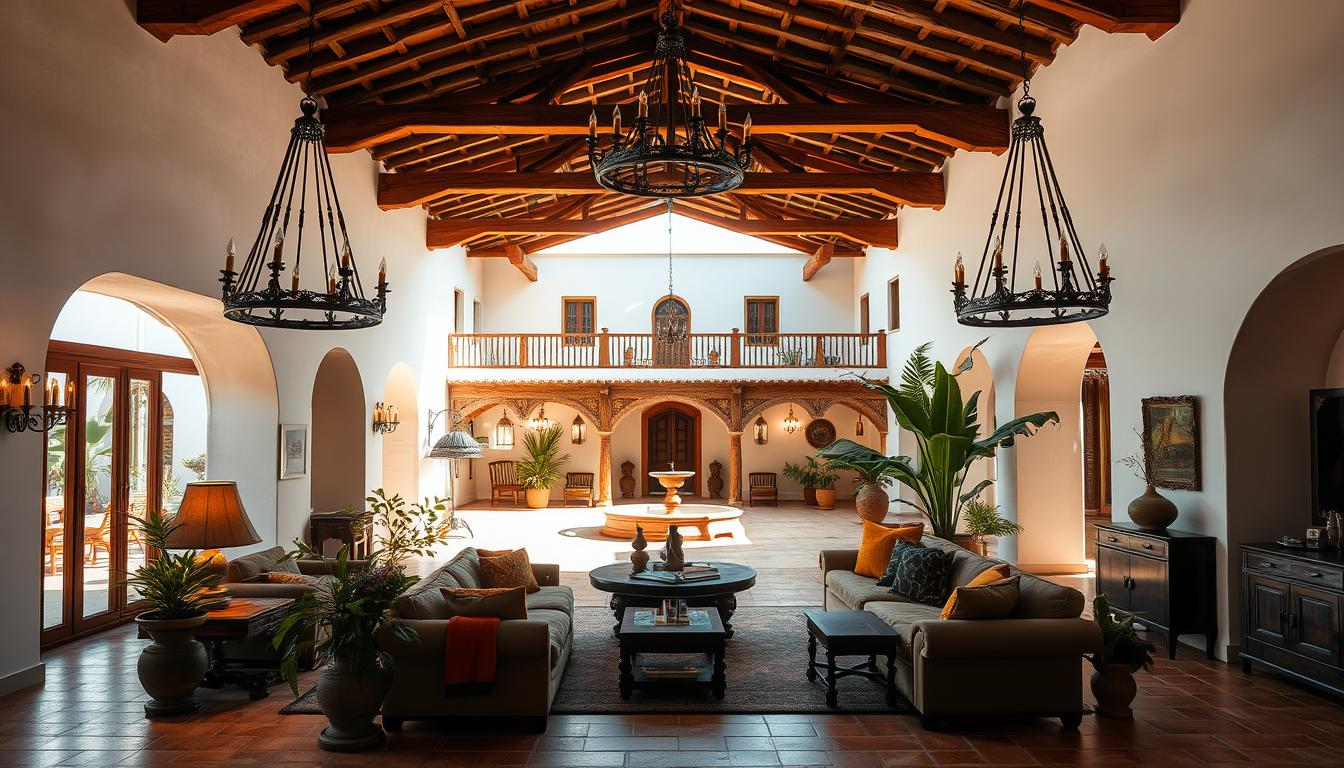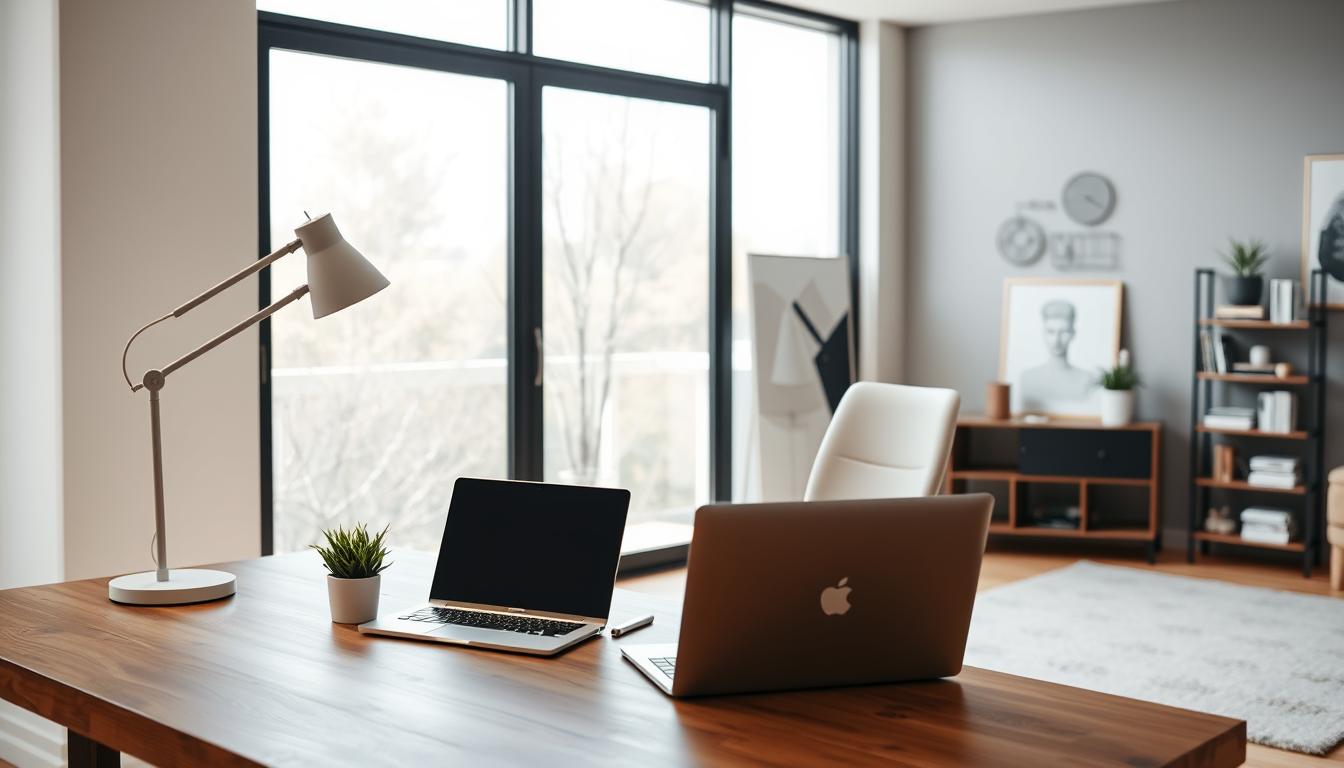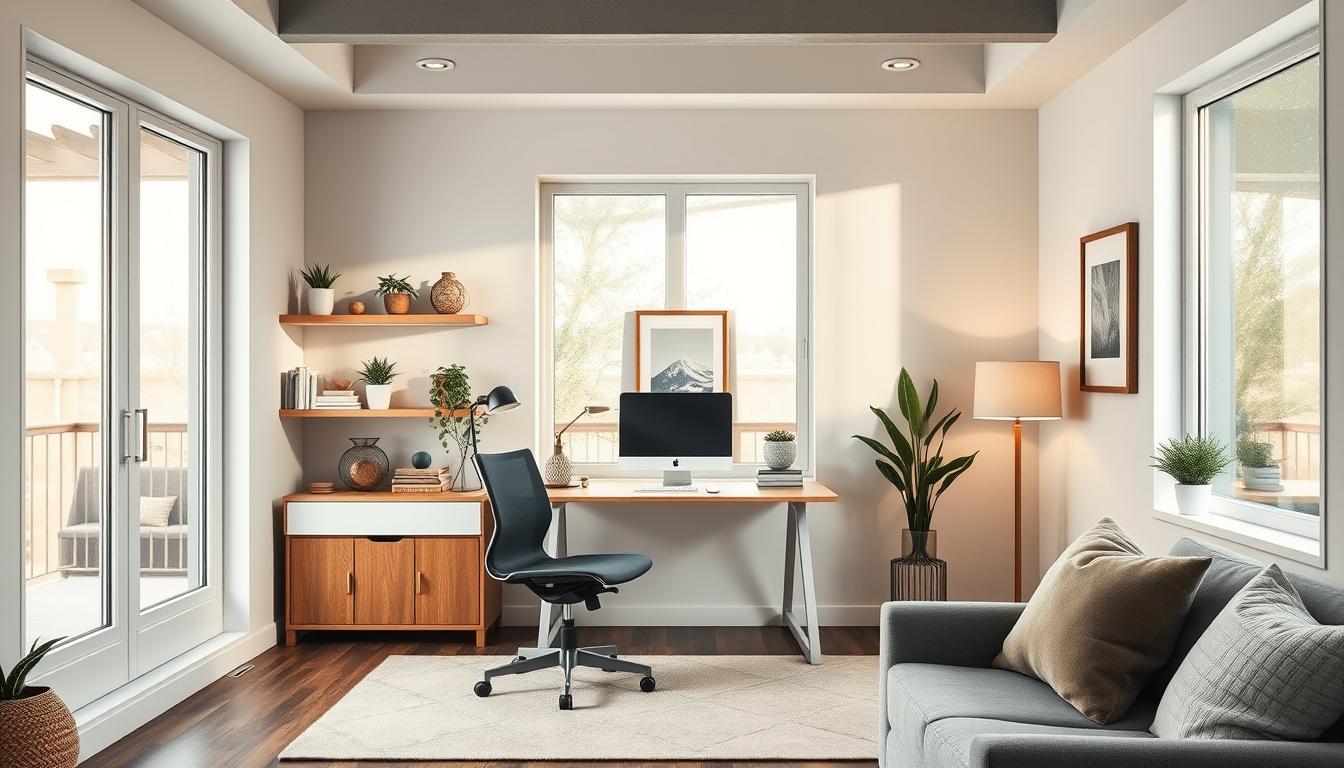Did you know Mediterranean interior design is a favorite for creating cozy homes? It’s inspired by Spain’s rich history and culture. It uses bright colors, detailed patterns, and natural materials.
We’ll show you how to make your living space a beautiful Spanish-style home. By learning about Spanish design, you can add its special touches to your spanish home interior. This will make your home feel warm and welcoming.
Key Takeaways
- Understand the essence of Spanish design and its cultural heritage.
- Learn how to incorporate vibrant colors and intricate patterns into your decor.
- Discover the importance of natural materials in Mediterranean interior design.
- Transform your living space into a Spanish-style haven.
- Create a unique and welcoming ambiance with Spanish-style interiors.
Understanding Spanish Home Interior Design
Spanish home interior design is a mix of centuries of culture, making it warm and welcoming. We’ll look at its key features, history, and how it’s updated in today’s homes.
Key Characteristics of Spanish Style
Spanish interior design is known for its warmth, richness, and exuberance. It includes:
- Terracotta Tiles: These tiles bring a warm, earthy feel to floors.
- Wooden Beams: Exposed beams add rustic charm.
- Ornate Ironwork: Decorative iron is used in lights, railings, and more.
- Vibrant Colors: The style often uses bright colors from Spain’s rich art history.
Historical Influences on Spanish Design
Spanish design has been shaped by cultures like the Moors, Goths, and Mediterranean ones. These are seen in its architecture and decor.
The Moorish influence is in the intricate tile work and arches. Gothic touches are in vaulted ceilings and ornate stone carvings.
Modern Interpretations of Spanish Style
Modern Spanish design mixes old and new, creating a unique look. This blend is captivating.
Modern takes on Spanish style include:
- Pairing traditional terracotta tiles with modern furniture for contrast.
- Adding bold, modern art to traditional decor.
- Using wood and stone in new ways to add texture and depth.
By combining tradition and modernity, Spanish design keeps evolving. It offers a rich mix for homeowners to explore.
Essential Elements of Spanish Interiors
To capture the essence of Spanish style in your home, it’s key to know the main elements. Spanish interiors are warm and inviting. This is thanks to natural materials, vibrant colors, and decorative elements.
Natural Materials
Spanish interior design often uses wood, stone, and terracotta. These materials make a room feel cozy and welcoming. For example, rustic Spanish home decor might use reclaimed wood and terracotta tiles.
Choosing furniture made from natural materials helps create a unified look. A wooden dining table with stone or terracotta tile flooring brings the outdoors in.
| Material | Characteristics | Uses in Spanish Interiors |
|---|---|---|
| Wood | Warmth, durability | Furniture, beams, flooring |
| Stone | Elegance, robustness | Flooring, fireplaces, countertops |
| Terracotta | Earthy feel, versatility | Tiles, pots, decorative items |
Vibrant Colors and Patterns
Spanish interiors are known for their bright colors and patterns. These elements add energy and life to a room. Spanish style furniture often has intricate patterns and bold colors.
To add vibrant colors and patterns to your home, use textiles like throw pillows and rugs. You can also include colorful pottery and ceramics for a Spanish touch.
Decorative Tiles and Ceramics
Decorative tiles and ceramics are key in Spanish interior design. Talavera and azulejos are common, adding elegance and sophistication. These elements can be used in various ways, like a kitchen backsplash or fireplace border.
By adding decorative tiles and ceramics, you can enhance your Spanish-inspired home. They add depth and visual interest.
Choosing the Right Color Palette
To get an authentic Spanish look, picking the right colors is key. The color palette is vital for a warm and welcoming Spanish-style interior.
Warm Hues for a Cozy Feel
Warm colors like terracotta, sienna, and golden brown are typical of Spanish homes. These hues make your home cozy and inviting, like a traditional Spanish hacienda.
Using warm earth tones on walls, floors, and furniture brings harmony to your home.
Combining Earth Tones and Bright Accents
Earth tones are the base of a Spanish-style color scheme. But, adding bright colors like turquoise, red, and yellow brings vibrancy. This makes your home colorful and lively.
By mixing these bright colors with earthy tones, we get a balanced and appealing color scheme. It shows off the modern Spanish interior style beautifully.
Choosing a color palette that mixes warm hues with bright accents makes your Spanish-style interior both authentic and lively.
Furniture Selection for Spanish Interiors
To capture the warmth and character of Spanish interiors, it’s essential to choose furniture that reflects the style’s rich heritage. The right furniture pieces can transport you to the sun-kissed landscapes of Spain, evoking a sense of warmth and hospitality.
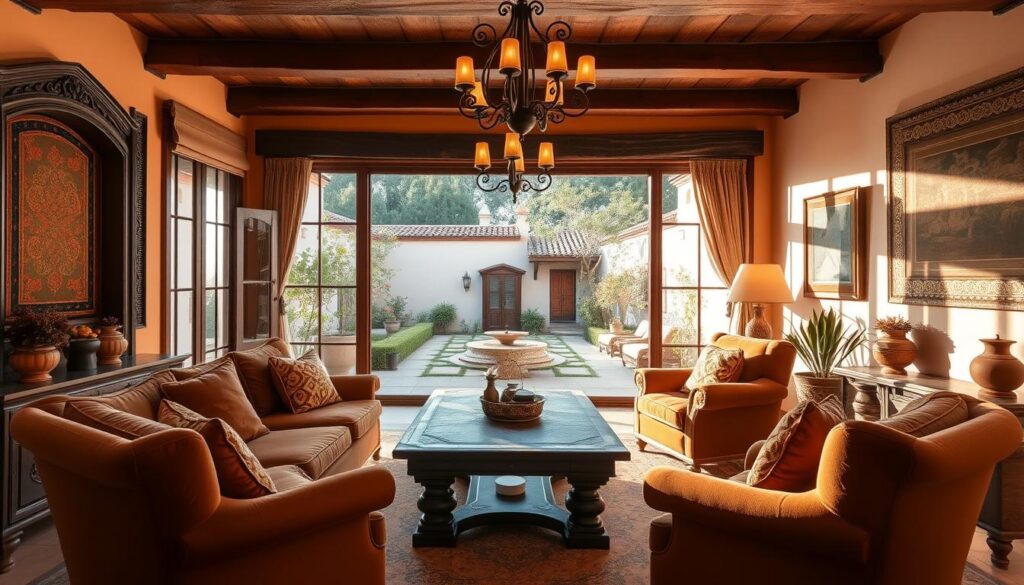
Rustic Wood Furniture
Rustic wood furniture is a staple of Spanish interior design. It’s known for distressed finishes and ornate carvings. These pieces add a touch of authenticity to any room. Look for furniture made from solid woods like oak or pine, which can be stained or painted to match your desired color palette.
The use of rustic wood furniture not only brings warmth to your space but also tells a story of tradition and craftsmanship. Each piece, with its unique imperfections, becomes a testament to the beauty of handmade furniture.
Upholstered Pieces with Spanish Flair
Upholstered furniture with Spanish flair can elevate the elegance of your interior. Intricately patterned fabrics and ornate trim are hallmarks of Spanish-style upholstery. Consider pieces with vibrant colors and bold designs that reflect the rich cultural heritage of Spain.
When selecting upholstered pieces, pay attention to the quality of the fabric and the craftsmanship. A well-made sofa or armchair can become the centerpiece of your living room, adding a layer of sophistication and comfort.
By combining rustic wood furniture with upholstered pieces that showcase Spanish flair, you can create a harmonious balance that defines the essence of Spanish home interior design.
Incorporating Textiles and Fabrics
Adding the right textiles and fabrics can make your Spanish decor pop. They bring warmth, depth, and character to any room. This makes them key in Spanish-style interiors.
Traditional Spanish Textiles to Consider
Traditional Spanish textiles are famous for their bright colors and detailed patterns. They are made from high-quality materials. Here are some notable ones:
- Silk: Silk adds elegance and sophistication to any space.
- Wool: Woolen blankets and throws are warm and show off Spanish weaving skills.
- Cotton: Cotton fabrics with embroidery are used in upholstery and curtains, adding a decorative touch.
Layering Fabrics for Depth and Interest
Layering fabrics is crucial in creating a warm Spanish-style interior. Mixing textures and patterns adds depth and interest. Here are some tips:
- Begin with a base layer, like a velvet sofa or a woven rug, to set the texture.
- Add a secondary layer with throw blankets, pillows, or embroidered fabrics for more texture and pattern.
- Finish with decorative elements like fringe or tassels for a final touch.
By using traditional Spanish textiles and layering them well, you can make a warm and inviting space. It will truly reflect your personal style.
Lighting Options for Spanish Homes
Lighting is essential in Spanish homes, mixing warmth with elegance. It creates a cozy and inviting atmosphere. This is a key part of traditional Spanish home design.
Embracing Natural Light
Natural light is a big part of rustic Spanish home decor. Large windows, skylights, and solar tubes let in lots of sunlight. This makes the space feel brighter and more airy.
It also shows off the beautiful architectural details of Spanish-style homes.
To get more natural light, try these tips:
- Install bigger windows or add skylights to let in more sunlight.
- Use sheer curtains or blinds to control the light.
- Keep windows clear of heavy drapery or furniture.
Choosing Decorative Fixtures
Artificial lighting can add elegance to your Spanish home. Wrought-iron chandeliers, pendant lights, and sconces are great choices. They show off Spanish craftsmanship.
Here are some tips for picking decorative lighting:
- Look for fixtures with detailed metalwork or ornate glasswork.
- Choose fixtures that match your home’s style, whether it’s modern or traditional.
- Make sure the fixture fits the room’s size; bigger spaces need bigger lights.
Mixing natural light with decorative fixtures can really improve your Spanish-style home. It makes the space warm, inviting, and truly Spanish.
Outdoor Spaces in Spanish Design
Spanish design is special because it blends indoor and outdoor spaces beautifully. This mix is a key feature of Spanish-style homes. It makes the lines between inside and outside fade away.
Outdoor areas in Spanish design are more than just extra space. They’re a big part of the look and feel of the home. You’ll find lovely courtyards, peaceful patios, and green gardens. These spots are made for relaxing or having fun.
Courtyards and Patios
Courtyards and patios are heart of Spanish outdoor design. They’re like private oases inside the home. Often, they’re surrounded by walls or buildings. These areas are filled with Spanish-style furniture, like fancy tiled tables and iron chairs, making them even more appealing.
To make a courtyard or patio stand out, think about adding fountains, plants, and lights. The sound of a fountain can be very calming. Plants and flowers add color and life to the space.
Incorporating Fountains and Plants
Fountains and plants are key to Spanish outdoor design. Fountains bring elegance and a calming sound. For plants, pick ones that are common in Spanish gardens, like olive trees, lavender, and bougainvillea.
For more ideas on creating beautiful Spanish-inspired spaces, indoors and outdoors, check out our guide at Estilo Lepa. It’s full of tips on bringing Spanish design into your home.
| Element | Description | Benefits |
|---|---|---|
| Fountains | Water features that add a soothing ambiance | Creates a calming atmosphere, masks background noise |
| Plants | Lush greenery and vibrant flowers typical of Spanish gardens | Adds color, texture, and life to outdoor spaces |
| Spanish-style Furniture | Intricately tiled tables, wrought-iron chairs | Enhances the aesthetic of outdoor spaces, provides comfort |
Accessorizing Your Spanish Interior
The final touches in creating a stunning Spanish villa interior involve thoughtful accessorizing. This is where we can truly make the space our own, infusing it with personality and flair.
Artwork that Complements the Style
Artwork plays a crucial role in enhancing the Spanish style. Consider incorporating vibrant tapestries, colorful ceramics, and ornate metalwork that reflect the rich cultural heritage of Spain. These pieces not only add visual interest but also help to create a cohesive look that ties the room together.
- Vibrant tapestries that add a pop of color
- Colorful ceramics that bring warmth to the space
- Ornate metalwork that adds a touch of elegance
Using Rugs and Other Textiles
Rugs and textiles are essential elements in Spanish interior design. Intricately patterned throw blankets and pillows can add a layer of warmth and texture to the space. When selecting rugs, look for those with traditional Spanish motifs or vibrant colors that complement the overall color palette.
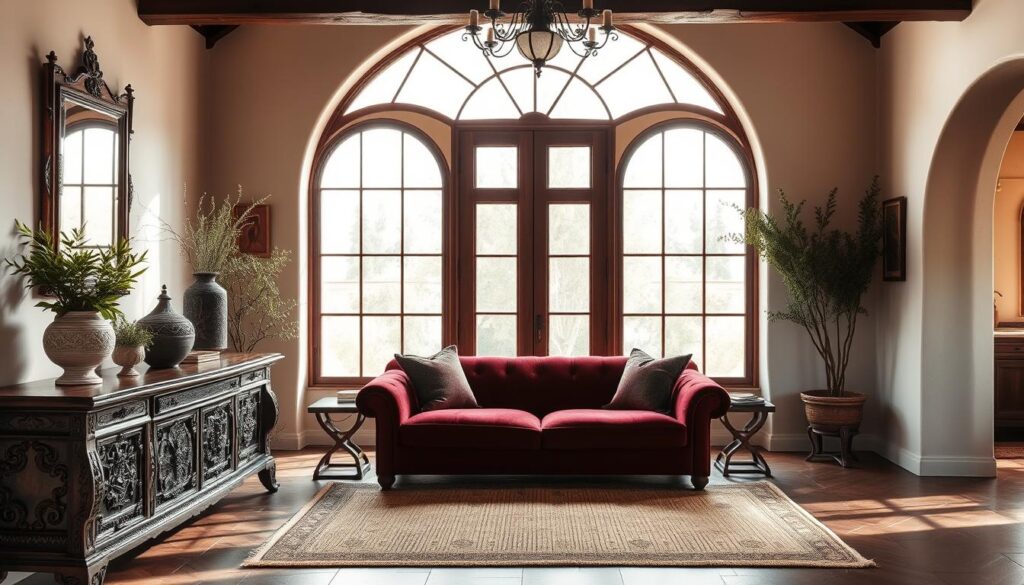
Some key considerations when choosing textiles include:
- Opting for materials that are durable and easy to maintain
- Selecting patterns and colors that complement the existing decor
- Layering different textures to add depth and interest
By thoughtfully accessorizing with artwork, rugs, and textiles, we can create a Spanish villa interior that feels both authentic and inviting. Incorporating colorful Spanish home accents will further enhance the space, making it a true reflection of Spanish style.
Bringing It All Together
When designing a Spanish-style interior, it’s key to combine all elements for a cohesive look. Using natural materials, vibrant colors, and decorative tiles creates a warm atmosphere. This makes the space inviting and authentic.
Design Cohesion
To achieve a unified look, a design plan is crucial. Choose a dominant color palette and use it everywhere. Add Mediterranean touches like terracotta and wrought iron to complete the look.
Personalizing the Space
Adding personal touches makes a Spanish-style interior truly special. Include family heirlooms and antique pieces. Handmade ceramics and bespoke textiles also add unique charm.
By following these tips, we can create a beautiful Spanish-style interior. It will reflect our personal style and complement traditional Spanish home design.
